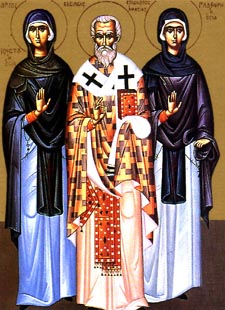|
|||
|---|---|---|---|
| This weekly bulletin insert complements the curriculum published by the Department of Christian Education of the Orthodox Church in America. This and many other Christian Education resources are available at http://dce.oca.org. | |||

The Church honors two saints whose lives intersected in an unusual way. They are the Righteous Virgin Martyr Glaphyra and the Hieromartyr Basil, Bishop of Amasea. The story of their meeting begins with Glaphyra, who was a maidservant to Constantia, half-sister of the emperor Constantine. Constantia's husband Licinius had assured Constantine that he was a Christian, and was given authority over the eastern part of the empire. But once he gained power, Licinius renewed his strong dedication to idol worship, and eagerly persecuted Christians. The young Glaphyra had the misfortune of attracting special attention from Licinius. He developed a fierce passion for her, and disconcerted the girl by staring lustfully at her. Glaphyra told the empress how uncomfortable this made her. Constantia, sorrowfully aware of her husband's ways but powerless to change them, decided to send Glaphyra away. The girl was dressed in men's clothing and given a sum of money. With another servant as companion, she set out for Pontus, and Licinius was told that she had been sent home to her family because she was close to death. Glaphyra and her companion broke their long journey at Amasea. The two strangers were warmly welcomed by Bishop Basil and his flock. In gratitude, Glaphyra gave her money to help with the construction of the new church the bishop was building. When she wrote to Constantia, telling her of the kind reception she had received, her overjoyed mistress sent enough money to finish the work. A courtier overheard Constantia making plans to send money to Glaphyra, and informed Licinius. In fury he ordered the governor of Amasea to send the bishop and the maidservant to him. Glaphyra died before she could be sent, but Saint Basil was forced to make the journey. At his trial, Saint Basil refused either to become a pagan priest or to worship idols, so he was sentenced to beheading. When the time came, he spared the executioner any guilt feelings by saying to him, "Friend, do as you have been ordered." The year was 322. Some of his priests were later told by an angel, "Bishop Basil is waiting for you in Sinope." They found his body in the waters near that town, and returned it for burial to the church in Amasea that he, with the unexpected help of Glaphyra and Constantia, had built. Mark 15: 43 to 16: 8 tells us about another time when a prominent man and a few simple women, who may not even have known each other, worked together to glorify God. In these verses, Joseph of Arimathea asks Pilate for the crucified body of Jesus, and buries it in a new tomb. Because he does this, "Mary Magdalene and Mary the mother of Joses saw where He was laid." The women then are able to perform their own loving act: they come in the morning to anoint the body. These "unlikely pairs" remind us that God works in ways that amaze us, even when we are the means by which He does the work. |
|||
